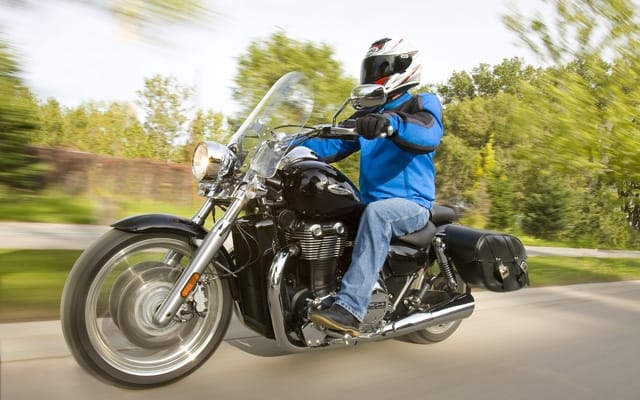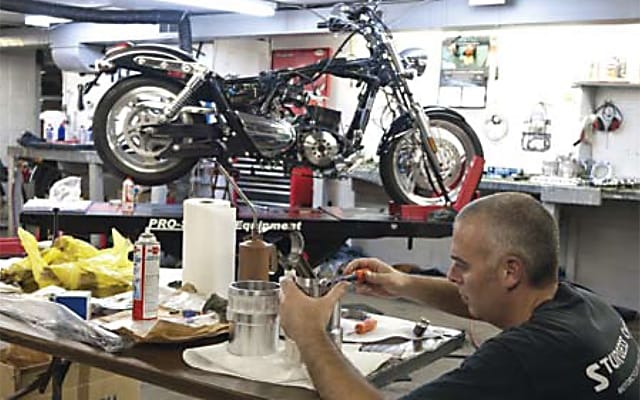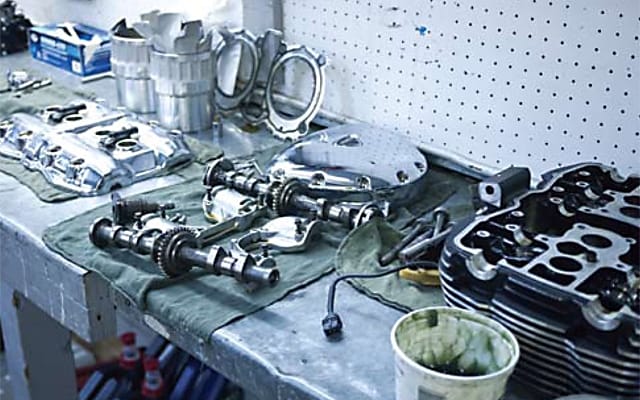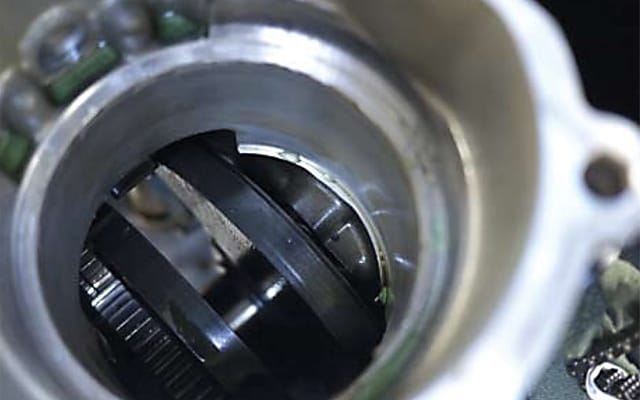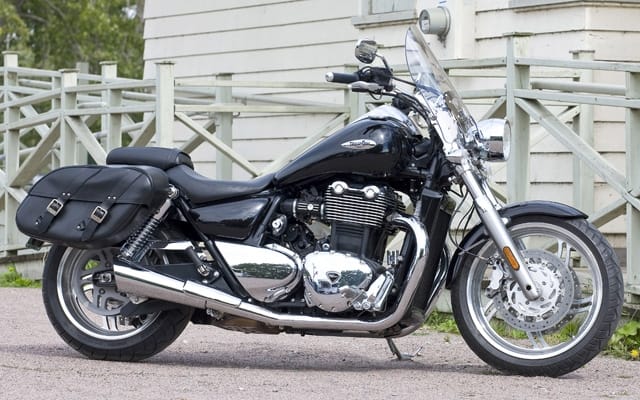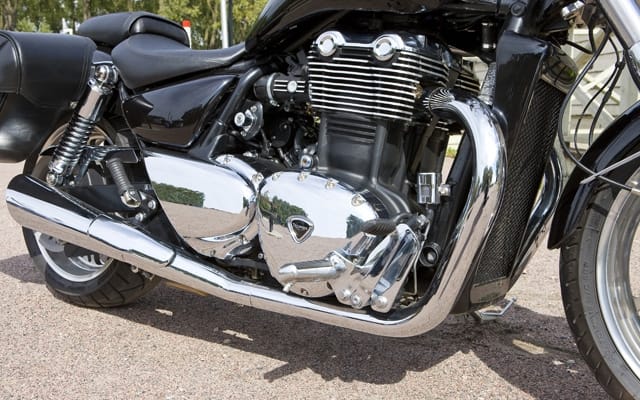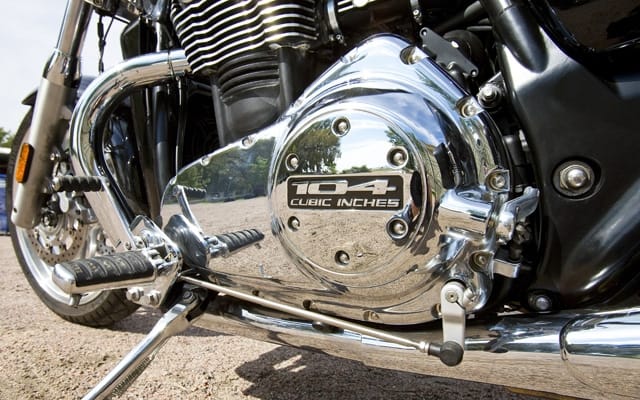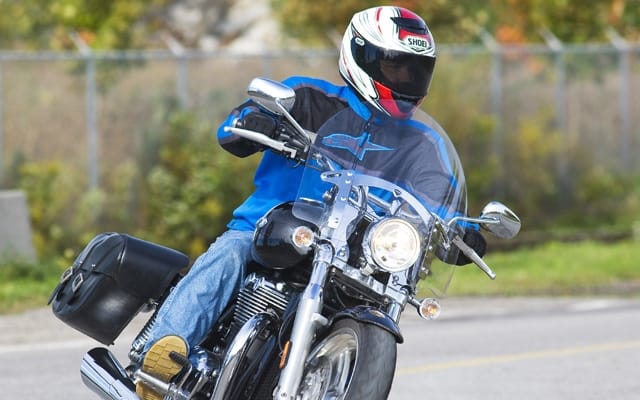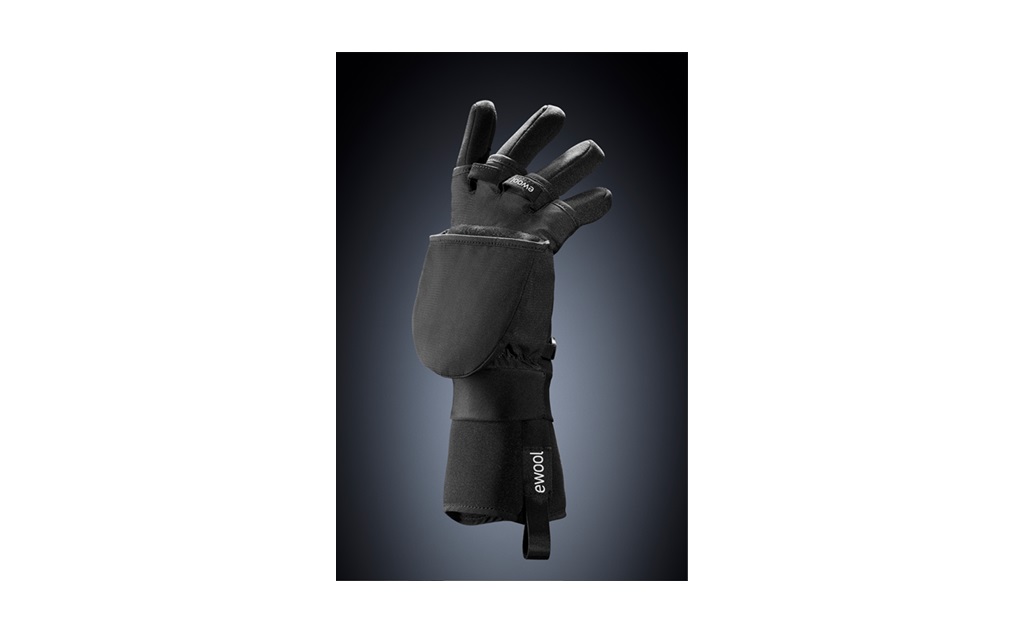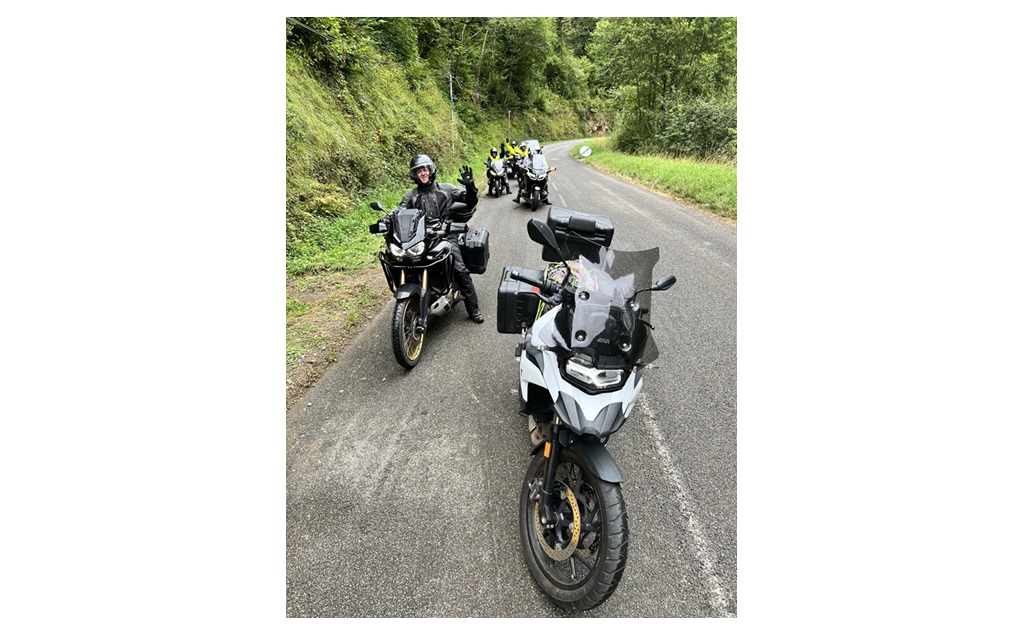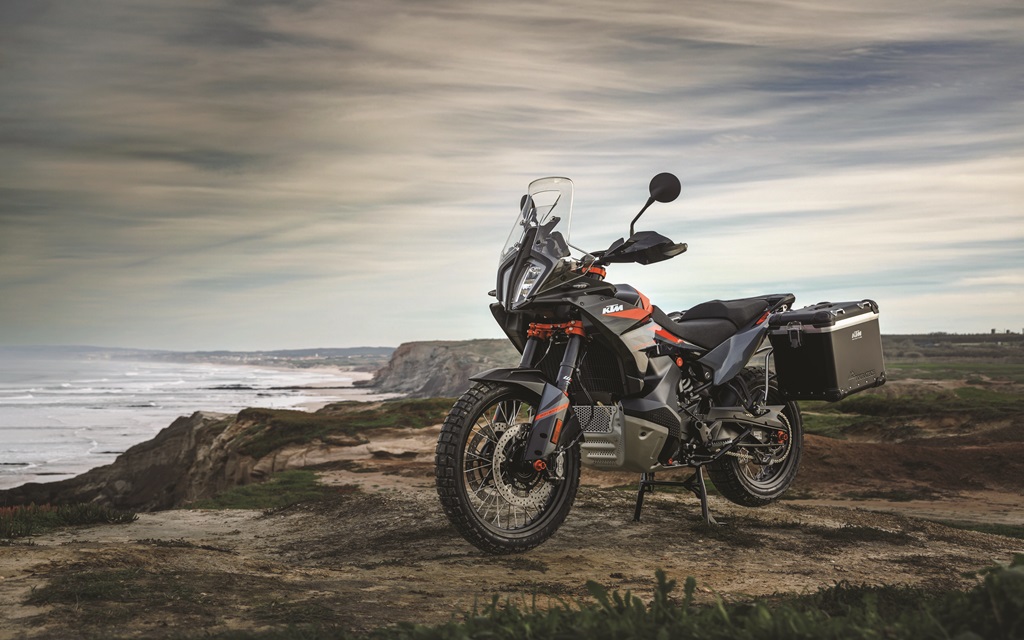It’s a big, black, long-legged cruiser with titanic power and a humongous vertical twin engine. So how do you improve it? Make it bigger, of course.
When the folks at Hinckley decided to provide more thrust for the Triumph Thunderbird, they turned to a tried-and-true philosophy: there’s no substitute for cubic inches.
But how many extra cubics make a better motorcycle? If you have your own factory, you can build an engine as large as you want, but there are practical limits: bigger engines add weight, and bigger power adds stress.
In stock form, the Thunderbird displaces 1,596 cc. The folks at Hinckley decided to make available a kit that would bump it up by 100 cc. To do it, they drew up a piston three millimetres greater in diameter, taking bore to 107 mm and bumping displacement to 1,690 cc.
That’s an increase of 1/16th of the original displacement, just over six percent. Well within the limits of practicality—but we’re not doing this to be practical. Can a six percent increase make a real difference in an engine’s power output? This is a big, shit-kicking cruiser; you feel it beneath you like you feel the movement of a bridge when a heavy truck goes by. We’ll get the numbers on paper to prove the case, but what we really want is a boot in the ass.
To get a basis for comparison, we took the Thunderbird to Pro 6 Cycle in Toronto and asked them to measure its stock output on their Dynojet dynamometer. They weren’t even sure it would fit on the thing, but with a bit of pushing and a lot of pulling, the Thunderbird was coaxed up a ramp and tied down on the rolling-resistance machine. The actual dyno run was a disappointing experience: the windows didn’t shake, and the fire department was not consulted. It wasn’t even loud. No one complained.
The results were interesting: only 75 hp, but a hefty 95 lb-ft of torque. And that torque value was spread wide and low: from about 2,300 rpm to about 4,200 rpm it registered at least 90 lb-ft. Horsepower, on the other hand, climbed swiftly to a peak that lasted from about 4,400 rpm to 5,100 rpm. With a street weight of about 750 lb, that’s a power-to-weight ratio of 1:10 on the horsepower-to-pounds scale. And it’s power-to-weight, not absolute power, that limits acceleration at speeds below about 160 km/h (above that, aerodynamics becomes more significant).
The dyno chart reflected what our seat-of-the-pants analysis told us. This bike is capable of moving quickly, but it’s severely constrained by its weight. On the road, it felt like a motorcycle with a bear of a motor, something that Winston Churchill might have admired. At 3,000 rpm, the Thunderbird’s 104 mm pistons were churning out maximum torque and sitting right on the edge of their horsepower field: strong, and just about to get fast. Yanking the throttle open in any of the lower gears at that engine speed produced a solid rush of acceleration that petered out quickly.
However, even more prominent than the sensation of accelerating was the sense of weight. It felt like a big engine was acting against a heavy drag. The word “anchor” comes to mind. And while the engine felt capable of doing the job against all that weight, there was no mistaking the effect of mass. Which leads one to a sensible conclusion: throw away about 100 pounds of mass and see what that engine can do. Ah, but if we were sensible, we’d be driving Ford’s Thunderbird, not Triumph’s.
September 22, 2010. Sturgess Cycle, Hamilton, Ontario. There’s a poster of Steve McQueen on the outside wall: the King of Cool. The service area is an underground bunker, reached from a sidestreet just off King Street. It’s about 55 feet long, 25 feet wide. There are pipes running across the low ceiling. There are wooden shelves, doors leading here and there, racks of things like batteries and small boxes of parts, dark corners and long, jagged cracks in the concrete floor. Sturgess Cycle is a hundred years old and looks it, but this is a well-equipped shop, with four service stations, each with a lift, and the mechanics look comfortable in their work.
In the last of four service areas, Luke Money is working on the T-bird. He’s about six feet tall, rangy, with a marine corps haircut and large, expressive eyes. He bends over a shop manual, reads for a few seconds, then moves on the bike, unscrewing something, twisting something, pulling something off. Then he’s back at the manual, bending at the hip, reading. On the radio, the White Stripes are playing Seven Nation Army.
“When did you get your mechanic’s licence?” we ask Luke. 1999, he says.
“Are you good at what you do?”
He looks away for a moment, thinking. “Well,” he says slowly, “I think I’m thorough. And I like fixing electrical stuff. Stuff that other people don’t like.”
But he’s having a little trouble with this job. Laid out on a table near him are the parts for this Thunderbird operation: two pistons, two cylinder liners, two cams, a set of clutch springs, piston rings, a head gasket, a valve cover gasket, an alternator cover, an exhaust system. On the floor beside the table, on a protective blanket, are parts he’s removed, the fuel tank, the exhaust system, seats, radiator, instrument pod. He says, “I keep finding more things to take off.”
The Triumph Thunderbird 1600 to 1700 conversion is so new, Luke hasn’t had a chance to practice it. Even the people at Triumph Canada seem a little perplexed by the job. They sent him the wrong cylinderliner puller. “It’s for the big-bore motor,” he says. He laughs, but later, he wonders aloud if he made the mistake himself, ordered the wrong tool.
And he’s getting conflicting information about major portions of the job. Should he remove the motor, or not? One source says yes, another says no—don’t pull the motor, just raise the bike and unfasten the connecting rods from the bottom. But the ceiling here is too low; if he hoists the bike up far enough to work under it, the guys upstairs in the showroom might try to sell it.
In the end, he leaves the motor in place and uses a rear-wheel lifter to jack up the back end of the bike, which allows him some angle-room to get at the underside and unscrew those connecting rods.
By the end of the first day, he’s got the motor through the final stages of disassembly: the head is off, cylinder liners out, pistons and connecting rods lying on the table. The cylinder liners look like thick metal cans, rough on the outside, smooth on the inside. They fit into the cylinders funny—there are odd spaces between the cylinder wall and the liner. I ask Luke about it. “That’s where the water goes,” he says. Of course: it’s a liquid-cooled engine.
Luke thinks he’ll complete the installation by this time tomorrow, provided nothing goes wrong. He’s been working at it all day, and he frequently had to stop and figure something out, or wrestle with some part that did not want to be moved, or ask for physical assistance. Scott Laidman comes over several times from the next work station to help out, grab something, push on something, help coax some part into place. Hands and fingers disappear into the half-assembled motor, faces grimace, a part moves grudgingly into place. Hands withdraw, fingers are counted.
Through it all, it’s easy to admire the process. Luke spends a lot of time thinking, but his hands are chipped here and there, and the force required to move large parts is expressed in his face as he grinds to it. In order to get the cylinder liners out, he has resorted to an old-school tool: duct tape. He drapes he upper portion of the liner with tape, tearing off strips and massaging them against the shiny, circular inside wall. When the motor is turned over by hand and a piston is forced up through the bore of the liner, its rings will bind on the duct tape, which will bind onto the liner wall, and the whole shebang will rise up out of the cylinder. So goes the theory, and Luke has used it in the past. But not in a long time. “Because, you know, we have the special tools now,” he says. He doesn’t appear to notice the irony in that statement.
Later, one of the upstairs guys comes by to get something. He’s talkative, friendly, standing there for a minute to watch Luke work. “One time,” he says, “I heard somebody called him the Triumph Whisperer.”
The following day, Luke gets the new pistons and cams into the motor, gets everything bolted back into place. The Triumph’s CPU is mapped for the new pistons, and he’s put on an accessory exhaust system, even a windscreen and saddlebags. He rides it home that evening, breaking it in, verifying that nothing will fall off. Later, when we pick it up from his Hamilton, Ontario, home, he tells us that it seems more punchy.
Indeed. Right off the bat, it sounds better, but that’s likely an effect of the new exhaust system. Punching the throttle earns a clear demonstration of the engine’s improved power: the bike jolts forward with more immediacy. In every gear, it feels stronger. It responds well to throttle inputs, too—even after a healthy power boost, the electronic fuel injection system never stumbles.
The Triumph has, however, balked at starting a couple of times. It seems vulnerable on hot days and a couple of times has required two or three attempts, cranking the motor for five seconds at a time, before it would start. The weather has cooled off after the big-bore kit was installed, and we don’t experience any more starting problems. In any event, the problem was infrequent, and it has never taken more than a couple of minutes to get it going.
A Triumph accessory exhaust system ($539) was installed with the big-bore kit and provides a pleasing, full-throated and slightly gritty sonic palette that is never offensively loud.
The accessory windscreen ($695.98) and saddlebags ($755) installed at the same time have turned the Thunderbird into a highway animal. It is no longer necessary to maintain a death grip on the handlebar at 120 km/h just to stay aboard. The leather saddlebags are large enough to hold a substantial amount of gear, and though some clutzy hook-and-loop patches make closing the bags a clumsy process, they seem secure and weather-proof.
A few days after the big bore kit is installed, we take the Triumph out to a country road and run it through the gears at full throttle. It responds with alacrity, but feels not so much stronger as more alert. The sensory effect is one of improved response time, rather than greater power. It just gets up and goes that much quicker. It feels like somebody has cut off about 100 pounds of mass.
Back at Pro 6 Cycle, where they once again wrestle the beast onto the Dynojet, the numbers tell the tale: 87.7 horsepower and 102.3 lb-ft of torque.
That’s a bump of 13.7 horsepower and 7.3 lb-ft of torque. The torque curves looks similar, with a strong initial rating that begins falling off at about 4,500 rpm. The character of the horsepower, on the other hand, is quite different. While both engines show a nice steady rise in output from low revs, the original engine’s 74 hp began to fall away at about 5,000 rpm, but the modified motor’s horsepower graph continues to rise to its peak at about 5,500 rpm; at 6,000 rpm, the modified engine makes about 84 horsepower, while the stock engine made about 66 horsepower at that engine speed.
Triumph’s hop-up kit is available not only in pieces, but in a complete motorcycle from the factory: the 1,700 cc model, in Phantom Haze Red paint, is $17,799, only $300 more than our hot-rodded 1,600 cc bike. Of course, buyers will deny themselves the pleasure of a before-and-after experience – and that’s not an insignificant thing. While the stock engine felt like a heavyweight bruiser, the hop-up kit transforms Triumph’s big vertical twin into something with flash. It may not be lighter in 1,700 cc form, but after having ridden it with the smaller motor, it feels lighter, and perception, as they say, is half the battle.
SPECIFICATIONS
MODEL Triumph Thunderbird (with big-bore kit installed)
PRICE $15,499 ($17,498)
ENGINE Liquid-cooled vertical-twin with four valves per cylinder
HORSEPOWER (MEASURED) 74 at 5,000 rpm (87.7 at 5,500 rpm)
TORQUE (MEASURED) 95 lb-ft at 3,000 rpm (102.3 lb-ft at 3,000 rpm)
DISPLACEMENT 1,596 cc (1,690 cc)
BORE AND STROKE 103.8 x 94.3 mm (106.8 mm x 94.3 mm)
COMPRESSION RATIO 9.7:1
FUEL DELIVERY EFI
TRANSMISSION Six-speed, belt final drive
SUSPENSION Telescopic 47 mm fork; dual rear shocks adjustable for preload
WHEELBASE 1,615 mm (63.5 in.)
RAKE/TRAIL 32 degrees/151 mm
BRAKES Dual front 310 mm rotors with four-piston calipers; rear 310 mm rotor with twin-piston caliper. ABS
TIRES 120/70-19 front; 200/50-17 rear
WEIGHT (CLAIMED) 339 kg (746 lb)
SEAT HEIGHT 700 mm (27.5 in.)
FUEL CAPACITY 22 L
FUEL CONSUMPTION 8.9 L/100 km; 32 mpg (9.9 L/100 km; 28 mpg)
FUEL RANGE 247 km (222 km)
